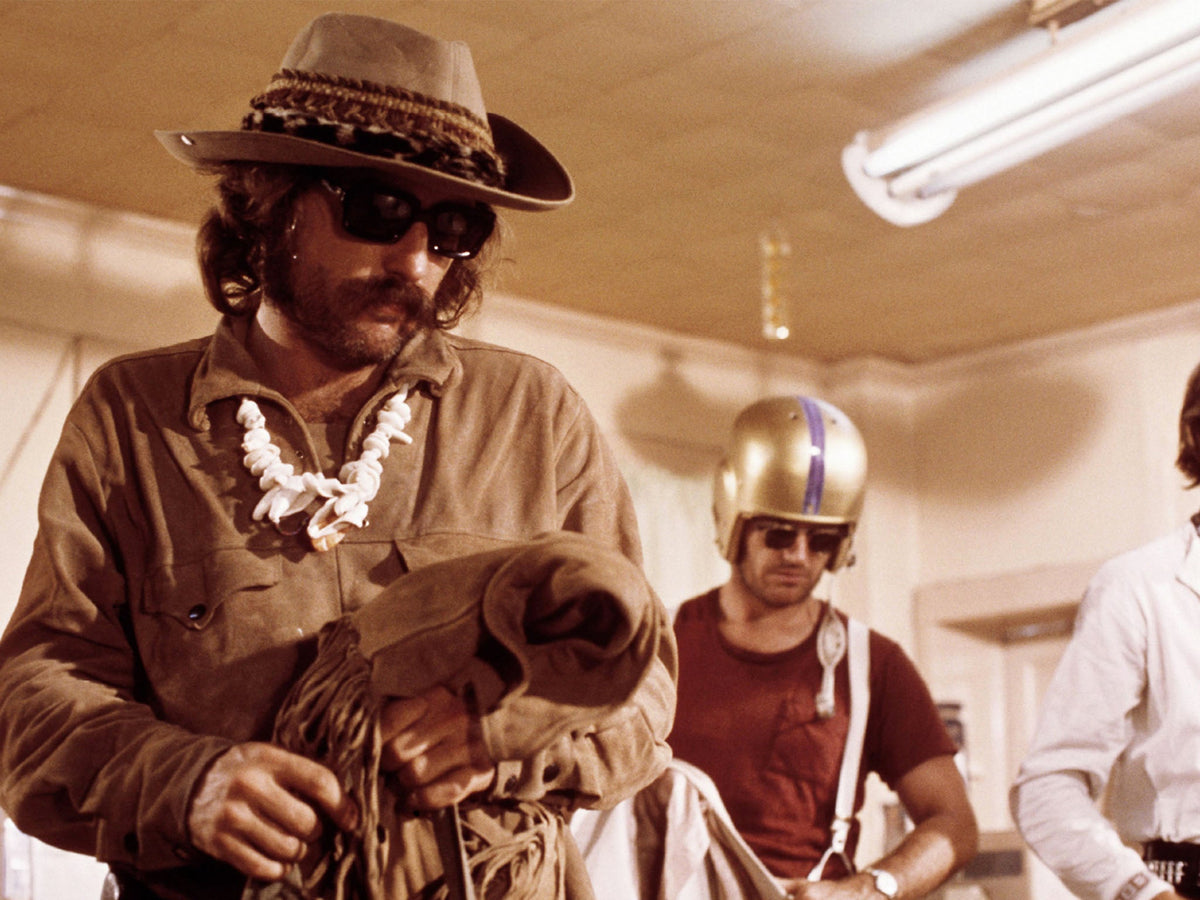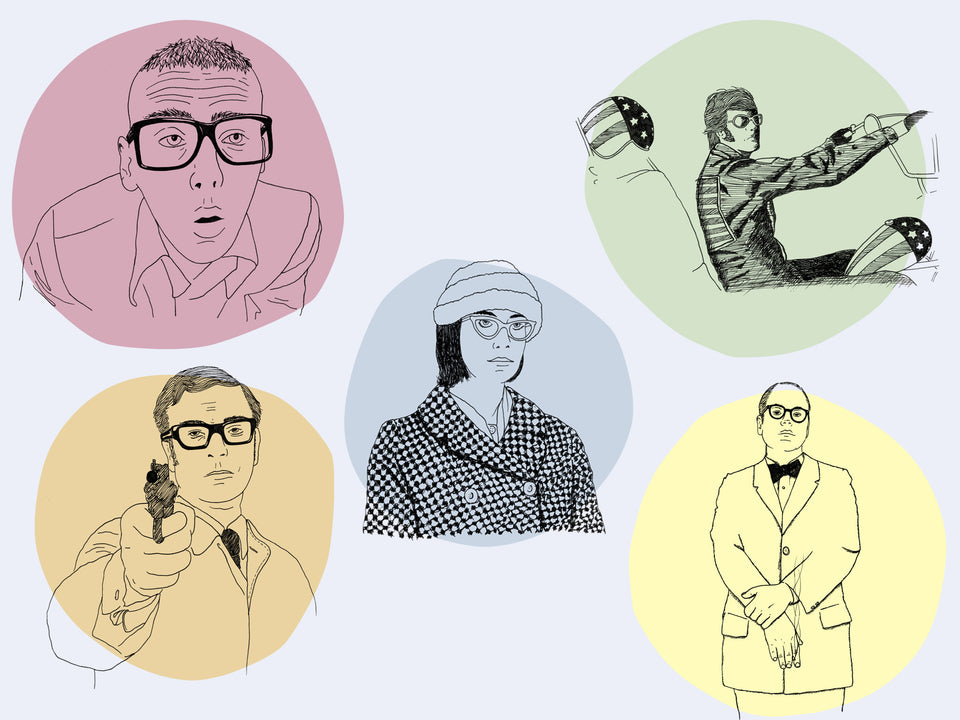As we've restocked Jacques Marie Mage's Dennis Hopper-inspired Taos sunglasses in four fine colourways - Army, Noir 4, Fade and Seed - we thought we’d retrace the iconoclastic actor/director/photographer’s tread marks from the set of Rebel Without a Cause, through the ups and downs of Easy Rider fame, to Taos, the remote New Mexico town that came to be his escape from the insanity of Hollywood. Here it goes...
Rebel, Rebel
In 1954, Rebel Without a Cause changed pretty much everything. In the wake of the wars their parents had fought, boomer teenagers appeared and began to occupy the cultural no man’s land between childhood and adulthood. In the film, James Dean’s portrayal of a juvenile delinquent solidified what it was going to mean to be young and rebellious. The teenager had arrived, they were every parent’s worst nightmare, and they had really, really great hair.
Dennis Hopper was just 19 when he starred as Goon in Rebel Without a Cause. He had grown up studying drama and at near enough his first punt at stardom he’d made it onto the cast of what would become one of the most important films in the 20th century. As you probably know, for Dean, his co-star and idol, that was the end of the road, but for Hopper the ride had just gotten started.

No sign of Hopper on the Rebel Without a Cause poster, but he was in the film, we promise.
From Hell to Texas and back again
Hopper didn’t take the death of James Dean particularly well. He’d lost someone he’d looked up to not long after he’d been thrust into the limelight. He became difficult to deal with, unmanageable, and the beginnings of the drink and drug problem that would blight his life until the early 80s were starting to show. On the set of western From Hell to Texas, he lost it, forcing one scene to be shot eighty times over the course of days. Furious, veteran director Henry Hathaway promised him he’d never work in Hollywood again and added his name to that notorious Hollywood blacklist.
For years, it looked like Hathaway was as good as his word. Hopper didn’t get cast in a single film and, while he did continue to study acting, he was forced to pursue other interests like photography, art, and cocaine. The blip didn’t last forever though. Luckily for Hopper, his aunty, a famous actress as it happened, called up an old friend of hers (John Wayne) and asked if he was still doing those cowboy films he used to do. He was, as it turned out, and yes, he did have a part for her nephew, actually.

Dude, where's my Chopper? Hopper as Billy in Easy Rider
The Comeback Kid
Following years of a career drought, Hopper found his diary looking full. In 1965 Wayne hooked him up with a bit part in The Sons of Katie Elder playing alongside Dean Martin and Wayne himself. Wayne again cast him in 1969, in the seminal True Grit. In between the two westerns, he also picked up a part in prison drama Cool Hand Luke as the bet-taker, Babalugats.
Hopper’s career was hotting up, but it was the film he was working on the screenplay for quietly with some friends that would come to define it.

Nice bikes, gnarly facial hair.
Not-so-easy Rider
It’s hard to overstate the importance of Hopper, Terry Southern, Peter Fonda, and Jack Nicholson’s vision for Easy Rider. If Rebel Without a Cause had marked the start of teenage-hood, Easy Rider’s sunglasses-clad hippies and their unfruitful search for freedom marked another, sadder point in history: the death of the 60s dream. As film and TV critic Charles Bramesco put it in this piece in the Guardian celebrating the 50th anniversary of the film’s release, “Easy Rider literally and symbolically marks the turning point at which the idealism of the 60s curdled into the indulgent solipsism of the 70s.”
The part-scripted film is full with metaphors and references to the clashing of the increasingly fractured American society, but it’s main characters Billy (Hopper) and Wyatt’s (Fonda) campfire conversation that is supposed to have captured the mood of the aging boomer generation at that time; “We blew it,” Wyatt insists.
The film remains a classic, but it wasn’t an easy film to make. The production was fraught with creative differences between Fonda and Hopper, Hopper's marriage broke down, and he was eventually pushed further towards using drugs and alcohol. Although Hopper was praised widely as the director, he wanted more credit for the screenplay, and fell out with Fonda as a result. Their relationship never recovered. As late as the 1998 Oscars, the pair were visibly frosty with each other. Despite making several attempts to contact Hopper while he was dying, Hopper never responded to Fonda and Fonda wasn’t even allowed inside the chapel for Hopper’s funeral.

Welcome to Taos
Following the fallout of Easy Rider, Hopper escaped to Taos, New Mexico. He’d discovered the small bohemian enclave while scouting for locations for Easy Rider and he’d fallen in love with it. It was a place historically chosen by artists and bohemians like D.H.Lawrence and socialite Millicent Rogers. Located in the beautiful Southern Rocky Mountains at 2600m altitude, it was riddled with the myth and mysticism of the local Native-Americans. Perhaps most importantly to Hopper, it felt a million miles away from Hollywood. Over the years, he’d return again and again, setting up art studios and throwing wild parties with the likes of Allen Ginsberg. He was eventually buried there in 2010.
Writing about the importance of Taos to her father in The New York Times Magazine, Hopper’s daughter Marin said that he “believed that being on the road in search of something was very American.” That’s probably what the Westerns he’d acted in represented to him and it was definitely at the core of Easy Rider, the search for freedom. But in Taos, ironically, Hopper didn’t need to keep looking. He’d found his own slice of freedom that he could call home.

The Taos from Jacques Marie Mage
Inspired by the creative spirit of Dennis Hopper, Jacques Marie Mage have partnered up with Hopper Goods to create a super-limited collection of eyewear named after Taos. The rectangular frames are influenced by the idealism and decadence of the 60s and take more than a few stylistic cues from the sunglasses that Hopper wore as Billy in Easy Rider. As Jacques Marie Mage put it, they’re “as suitable for the spiritual thrill-seeker as they are for the secular sophisticate.” So, if you’re either of them, they’re probably worth having a look at.
We’re delighted to be restocking the Taos in four fine colourways. The frames in Seed, Army, Fade, and Noir 4 are all handmade in Japan from 10mm block acetate and they all feature Jacques Marie Mage’s famously decadent detailing, like a native engraved inner core. They also all look really, really nice, don't they?
Shop the collection below or, if you’re a hands on kind of person, book a styling appointment with us here and come to our Manchester opticians to take a look at them in real life.




